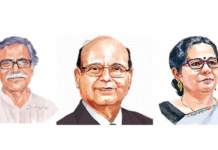A year has passed since the world learnt about the attack of the novel coronavirus. Countries around the world are still grappling with the fallout from the devastating Covid-19 pandemic. They have introduced stimulus packages to reduce the impact of the pandemic on the economy and society. The amount of stimulus packages varies from country to country based on their capacities and requirements. The strategies of providing the stimulus packages and their effectiveness are also different across countries.
During all economic crises, while rolling out stimulus packages, three issues are critical. These are timeliness, targeting and exit plan. The effectiveness of the stimulus packages announced by the government of Bangladesh can be assessed within this framework.
First, to tackle the immediate crisis due to the pandemic, Bangladesh’s policymakers announced the crisis-phase support as soon as the pandemic hit the economy. The government announced several stimulus packages since the end of March 2020 to help the affected people stay afloat and boost economic activities. According to the Ministry of Finance (MoF), government’s support measures include increasing government expenditure, providing loans at low interest rates, expansion of social safety net programmes, and raising the money supply. Broadly, these fall into two categories—fiscal and monetary measures.
According to a report published by the MoF in November 2020, the government announced Tk 121,353 crores worth of stimulus packages. This is equivalent to 4.3 percent of gross domestic product of the country. One of the important features of Bangladesh’s stimulus packages is that these are more of liquidity support and less of fiscal stimulus. Of the total stimulus packages unveiled so far 80.7 percent (3.5 percent of GDP) is liquidity support and 19.3 percent (0.8 percent of GDP) is fiscal stimulus. However, given that Bangladesh has resource constraints, the introduction of the stimulus package is a welcome move.
Second, the government also targeted sectors for support through an assessment of the sectoral distress and need. Liquidity support has been provided to the export-oriented industries, large industries and service sector organisations, and cottage, micro small and medium enterprises (CMSMEs). Additionally, such support has been announced in the form of increased Export Development Fund of Bangladesh Bank, pre-shipment credit refinance scheme, refinancing scheme for the agriculture sector, low-income farmers and small traders, loans for job creation, government subsidy for interest waiver of deferred bank loans for the month of April-May 2020 and credit guarantee scheme for SMEs.
However, not all sectors have been able to access the allocated funds with the same success. Only the export-oriented industries used 100 percent of its allocation. In the large industries category, a total of 2,549 large business entities have accessed 71 percent of the allocated loans till October 31, 2020. Disbursement from the Export Development Fund was 81 percent and for agriculture refinancing scheme 45 percent till October 2020.
The progress in other disbursements is much lower. For example, in case of CMSMEs, only 32 percent of the allocated fund has been disbursed as of October 2020. An amount of Tk 3,200 crores has been allocated for self-employment and business for migrant workers from abroad and trained and unemployed youths. Four organisations such as Village Savings Bank, Ansar-VDP Bank, Expatriates’ Welfare Bank and Palli Karma Sahayak Foundation (PKSF) will distribute Tk 500 crores each while the Employment Bank will distribute Tk 1,200 crores. PKSF has started the loan programme with a fund of Tk 250 crores. The other four organisations have disbursed Tk 428 crores as loans.
In case of fiscal stimulus, disbursement for rice distribution at a lower price was fully implemented. However, information on the number of people who benefitted from this support is not known. A total of 50 lakh households were to be provided Tk 2,500 as cash support. A total of about 35 lakh households (70 percent) received this support till October 2020. Among the recipients, 75 percent households are headed by males and 25 percent are headed by females. In case of agricultural subsidies, 76 percent has been disbursed during the same period.
Overall, in case of targeting, the stimulus packages covered several sectors, some of which have benefitted due to the support. However, disbursement to a number of sectors including CMSMEs, women entrepreneurs, migrant workers and youth employment is still low while they are in dire need of support. Besides, direct cash transfers to the poorest households are inadequate compared to the need of both the existing and the new poor. The selection criteria of the beneficiary of this cash support has been fraught with challenges of mistargeting.
Third, all crisis-period support measures have to be temporary in nature to avoid fiscal burden on the government in the long run. The government must have an exit plan for phasing out the support. A successful exit plan will depend on how successfully the stimulus packages have been utilised. The government has set timelines for the stimulus packages for each sector. Since most of the stimulus is in the form of bank loan, this facility must be time bound. There is also a need to have strong supervision and monitoring of bank loans to avoid the risk of loan default.
In view of the second wave of the pandemic, some countries have announced a second round of stimulus packages. Bangladesh will also have to do the same soon. The new package should serve two broad objectives. First, they should support those who remained outside the first round but are suffering financially. These must include the informal sector workers, the urban poor, women, the elderly and the youth. Second, this stimulus should be utilised for economic revival in the long-run.
The success and effectiveness of the first round of stimulus packages can be a valuable lesson for the second round. One of the lessons is that crisis of such scale and extent requires stronger fiscal measures than monetary measures. In a depressed economic situation, demand for bank loan is low. This is the time when aggregate domestic demand has to be boosted through higher public spending so that jobs are created and people have money to spend. A large number of poor people will also need cash handouts. Fiscal measures will clearly require creation of fiscal space which is currently narrow. Domestic resource mobilisation efforts have to be scaled up. Therefore, reform of the tax system will have to be pursued parallelly along with support measures to protect people’s livelihoods, save businesses, consolidate what has been achieved and move forward to rebuild the economy.
Thus, for Bangladesh and countries with limited resources, fiscal stimulus should have a number of specific long-term objectives. First, in order for people to absorb future shocks, universal social protection and universal healthcare should be introduced. Second, the increased public expenditure should be on healthcare and education sectors for improving the quality of human capital. Third, government investment should be for technology and innovation to cope with the changing mode of education, work, business and service delivery. Fourth, public investment should be made on institutional strengthening for better quality of services. Fifth, fiscal stimulus should be provided for green infrastructure to make economic recovery sustainable.
Dr Fahmida Khatun is the Executive Director at the Centre for Policy Dialogue.
Views expressed in this article are those of the author and do not necessarily reflect the position of her organisation.










